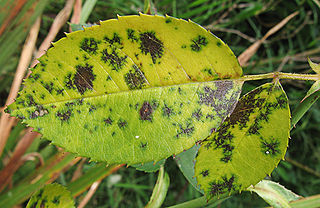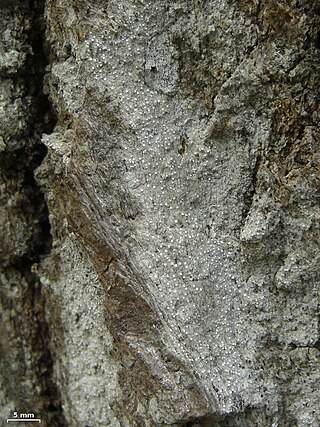Related Research Articles

Basidiomycota is one of two large divisions that, together with the Ascomycota, constitute the subkingdom Dikarya within the kingdom Fungi. Members are known as basidiomycetes. More specifically, Basidiomycota includes these groups: agarics, puffballs, stinkhorns, bracket fungi, other polypores, jelly fungi, boletes, chanterelles, earth stars, smuts, bunts, rusts, mirror yeasts, and Cryptococcus, the human pathogenic yeast.

Ascomycota is a phylum of the kingdom Fungi that, together with the Basidiomycota, forms the subkingdom Dikarya. Its members are commonly known as the sac fungi or ascomycetes. It is the largest phylum of Fungi, with over 64,000 species. The defining feature of this fungal group is the "ascus", a microscopic sexual structure in which nonmotile spores, called ascospores, are formed. However, some species of the Ascomycota are asexual, meaning that they do not have a sexual cycle and thus do not form asci or ascospores. Familiar examples of sac fungi include morels, truffles, brewers' and bakers' yeast, dead man's fingers, and cup fungi. The fungal symbionts in the majority of lichens such as Cladonia belong to the Ascomycota.

Rusts are fungal plant pathogens of the order Pucciniales causing plant fungal diseases.

A conidium, sometimes termed an asexual chlamydospore or chlamydoconidium, is an asexual, non-motile spore of a fungus. The word conidium comes from the Ancient Greek word for dust, κόνις (kónis). They are also called mitospores due to the way they are generated through the cellular process of mitosis. They are produced exogenously. The two new haploid cells are genetically identical to the haploid parent, and can develop into new organisms if conditions are favorable, and serve in biological dispersal.

Diplocarpon rosae is a fungus that creates the rose black spot disease. Because it was observed by people of various countries around the same time, the nomenclature for the fungus varied with about 25 different names. The asexual stage is now known to be Marssonina rosae, while the sexual and most common stage is known as Diplocarpon rosae.
Zythiostroma is a genus of canker fungus in the family Nectriaceae. The two or three species in the genus, which are anamorphs of the genus Nectria, have been found in Europe and Java.
This is a glossary of some of the terms used in phytopathology.

Ophiostoma ulmi is a species of fungus in the family Ophiostomataceae. It is one of the causative agents of Dutch elm disease. It was first described under the name Graphium ulmi, and later transferred to the genus Ophiostoma.

Diplocarpon earlianum is a species of fungus that causes disease in strawberry plants called strawberry leaf scorch. The disease overwinters in plant debris and infects strawberry plants during the spring season when it is wet. The five main methods to reduce strawberry leaf scorch include: irrigation techniques, crop rotation, planting resistant and disease-free seeds, fungicide use, and sanitation measures. Control of strawberry leaf scorch is important because it is responsible for the majority of disease in strawberries. Diplocarpon earliana affects the fruit quality and yield of the strawberry crop. Losses range from negligible to severe depending on numerous epidemiological factors including cultivar susceptibility, type of cropping system, and weather conditions

Diaporthe helianthi is a fungal pathogen that causes Phomopsis stem canker of sunflowers. In sunflowers, Phomopsis helianthi is the causative agent behind stem canker. Its primary symptom is the production of large canker lesions on the stems of sunflower plants. These lesions can eventually lead to lodging and plant death. This disease has been shown to be particularly devastating in southern and eastern regions of Europe, although it can also be found in the United States and Australia. While cultural control practices are the primary method of controlling for Stem Canker, there have been a few resistant cultivars developed in regions of Europe where the disease is most severe.

Scorias spongiosa is a sooty mold fungus that grows on aphid honeydew. It is a member of the Capnodiaceae family of ascomycete fungi. It is found only on American beech trees, Fagus grandifolia.

The fungi imperfecti or imperfect fungi are fungi which do not fit into the commonly established taxonomic classifications of fungi that are based on biological species concepts or morphological characteristics of sexual structures because their sexual form of reproduction has never been observed. They are known as imperfect fungi because only their asexual and vegetative phases are known. They have asexual form of reproduction, meaning that these fungi produce their spores asexually, in the process called sporogenesis.

Phomopsisblight of juniper is a foliar disease discovered in 1917 caused by the fungal pathogen Phomopsis juniperovora. The fungus infects new growth of juniper trees or shrubs, i.e. the seedlings or young shoots of mature trees. Infection begins with the germination of asexual conidia, borne from pycnidia, on susceptible tissue, the mycelia gradually move inwards down the branch, and into the main stem. Management strategies mainly include removing and destroying diseased tissue and limiting the presence of moisture on plants. Junipers become resistant to infection as they mature and the young yellow shoots turn dark green. Preventive strategies include planting only resistant varieties and spraying new growth with fungicide until plants have matured.
Coelomycetes are a form-class of fungi, part of what has often been referred to as fungi imperfecti, Deuteromycota, or anamorphic fungi.
Sphaeropsidales is an order of Coelomycetes fungi.
Teuvoa is a genus of lichen-forming fungi in the family Megasporaceae. It was first classified by lichenologists Mohammad Sohrabi and Steven Leavitt in 2013, with Teuvoa uxoris asigned as the type species. This genus was delineated from the larger genus, Aspicilia, following a molecular phylogenetic analysis which revealed that the Aspicilia uxoris species group constituted a distinct lineage in the Megasporaceae. Initially containing three species, two additional species native to China were added in 2018. Teuvoa is characterised by its small ascospores and conidia, and the absence of secondary metabolites.
Opegrapha vulpina is a species of lichenicolous (lichen-eating) fungus in the family Opegraphaceae. It is found in the Czech Republic, Dobruja, Romania, and the Italian Apennine Mountains. It grows parasitically on two species of saxicolous (rock-dwelling), crustose lichens.
Neosergipea septoconidiata is a species of corticolous (bark-dwelling) lichen in the family Roccellaceae. It is a unique species of lichen that grows on the bark of trees in the primary forests of Brazil with its bluish-grey thallus and bright orange pycnidia that have a fluffy hyphal surface.

Sporodophoron is a genus of lichen-forming fungi in the family Arthoniaceae. It includes four corticolous (bark-dwelling) crustose lichen species. Sporodophoron is uniquely characterised by the formation of structures called sporodochia, which are open conidiomata in the form of tufts of conidiophores on the thallus. Although these lichens bear a strong resemblance to Inoderma, another genus within the same family, Sporodophoron's distinct chemical makeup sets it apart from its lichen relatives. Collectively, the genus has a widespread geographical distribution in the Northern Hemisphere, with species found in distinct habitats in North America, Europe, Japan, and the Russian Far East.
Falcocladium is a genus of fungi, within the monotypic family FalcocladiaceaeSomrith., E.B.G. Jones & K.L. Pang, and within the monotypic order FalcocladialesR.H. Perera, Maharachch., Somrith., Suetrong & K.D. Hyde, within the class Dothideomycetes. They are saprobic on leaf litter, including the leaves of Eucalyptus grandis and Eucalyptus camaldulensis in tropical and terrestrial habitats.
References
- ↑ Hernandez, G. 2006.Fungus of the month: Coelomycetes.The Environmental Reporter Volume 4 | Issue 6
- ↑ Fulbright, D. 2008. Stigmina found associated with needle cast on blue spruce in Michigan. Accessed December 15, 2010 at "Stigmina found associated with needle cast on blue spruce in Michigan > IPM - Crop Advisory Team Alerts - Landscape > MSU Landscape Alert newsletter". Archived from the original on 2010-06-28. Retrieved 2010-12-20.
- ↑ Cortez, K. J. (2008). "Infections Caused by Scedosporium spp". Clinical Microbiology Reviews. 21 (1): 157–97. doi:10.1128/CMR.00039-07. PMC 2223844 . PMID 18202441.